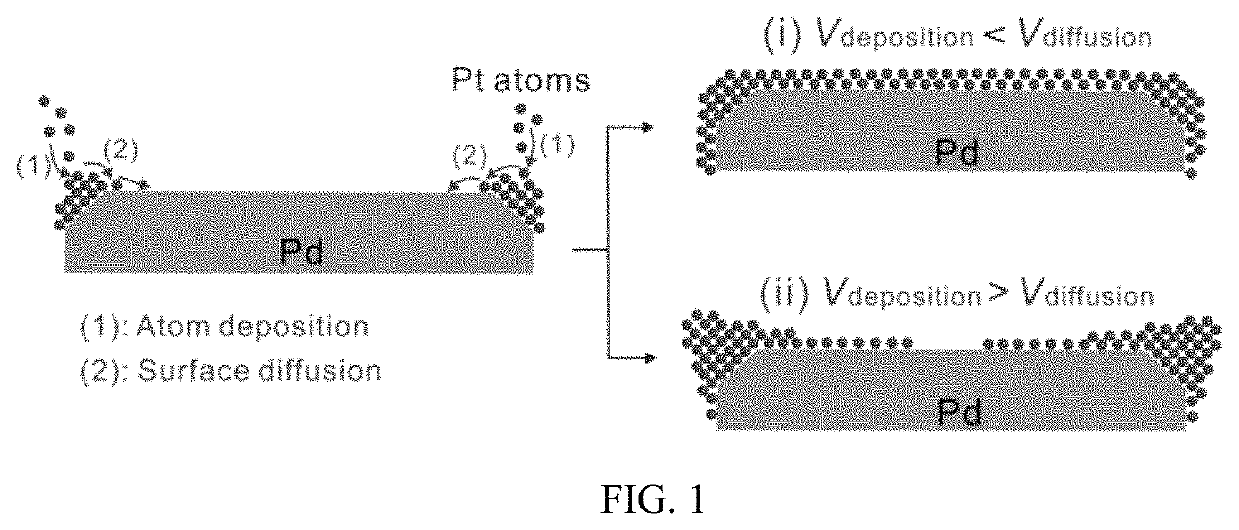Layered platinum on freestanding palladium nano-substrates for electrocatalytic applications and methods of making thereof
a freestanding, platinum-coated, nano-substrat technology, applied in the direction of physical/chemical process catalysts, cell components, metal/metal-oxide/metal-hydroxide catalysts, etc., can solve the problem of surface coverage problems, platinum-coated palladium particles cannot be extended to substrates having nanometer sizes or to form coatings on substrates in solution phase,
- Summary
- Abstract
- Description
- Claims
- Application Information
AI Technical Summary
Benefits of technology
Problems solved by technology
Method used
Image
Examples
example 1
Preparation of Pd@PtnL (n=1-6) Nanocubes
[0114]For the synthesis of Pd@PtnL (n=1-6) nanocubes, 1.0 mL of the 18 nm cubic Pd seed dispersion (1.68 mg / mL, as determined from ICP-MS and TEM measurements), L-ascorbic acid (100 mg), KBr (54 mg), PVP (66.6 mg), and 12 mL of EG were mixed in a 50 mL flask and pre-heated at 110° C. for 1 hour. The reaction temperature was then quickly ramped up to 200° C. within a 10 min period. Subsequently, the deposition of the Pt atomic layers was initiated by injection of a given volume of a Na2PtCl6.6H2O solution in ethylene glycol (0.25 mg mL−1) into the pre-heated reaction solution at a relatively slow rate of 4.0 mL h−1 (˜10.0 μL per droplet). After the injection of a specific amount of the platinum precursor, the reaction solution was kept at 200° C. for another 1 hour. The final Pd@PtnL nanocubes were collected by centrifugation, washed ethanol (2×) and DI water (3×), and subsequently re-dispersed in DI water.
[0115]Characterization of Pd@PtnL Nano...
example 2
Preparation of the Pd@PtnL (n=2-5) Octahedra in a Polyol-Based System
[0120]For the synthesis of Pd@PtnL (n=2-5) octahedra, 1.0 mL of the Pd octahedra EG suspension (19 nm in edge length, 0.83 mg mL−1), PVP (67 mg), L-ascorbic acid (100 mg), KBr (54 mg), and 12 mL of EG were mixed in a flask and heated at 110° C. for 1 hour under magnetic stirring. The temperature was then quickly ramped up to 200° C. within 20 min and a specific amount of an EG solution containing Na2PtCl6.6H2O (0.1 mg mL−1) was added dropwise with a syringe pump at a rate of 4.0 mL h−1. After complete injection, the reaction solution was kept at 200° C. for 1 hour under magnetic stirring and subsequently cooled to room temperature. The Pd@PtnL octahedra were collected by centrifugation, washed with ethanol (2×) and with DI water (3×), and subsequently re-dispersed in DI water.
[0121]Characterization of Pd@PtnL Octahedra(Polyol-Based Protocol):
[0122]The number of platinum atomic overlayers was controlled as a functio...
example 3
Preparation of the Pd@PtnL (n=2-3) Octahedra in a Water-Based Solvent
[0126]For the synthesis of Pd@PtnL (n=2-3) octahedra, PVP (35 mg) and citric acid (60 mg) were added into 10 mL of the aqueous suspension of the Pd octahedra (15 nm, 0.19 mg mL−1) and then heated at 95° C. for 10 min under magnetic stirring. Separately, K2PtCl4 (13 mg) was dissolved in 3 mL of DI water and the solution was quickly added into the pre-heated solution using a pipette. The reaction solution was kept at 95° C. for 24 hours under magnetic stirring and subsequently cooled down to room temperature. The Pd@PtnL (n=2-3) octahedra were collected by centrifugation, washed with DI water (3×), and subsequently re-dispersed in DI water.
[0127]Characterization of Pd@PtnL Octahedra (Water-Based Protocol):
[0128]High-angle annular dark-field scanning TEM (HAADF-STEM) images of Pd@Pt2-3L octahedra are shown in FIGS. 6A-E. During the deposition of platinum atomic overlayers, the overlayers produced were uniformly epitax...
PUM
| Property | Measurement | Unit |
|---|---|---|
| size | aaaaa | aaaaa |
| thickness | aaaaa | aaaaa |
| temperature | aaaaa | aaaaa |
Abstract
Description
Claims
Application Information
 Login to View More
Login to View More - R&D
- Intellectual Property
- Life Sciences
- Materials
- Tech Scout
- Unparalleled Data Quality
- Higher Quality Content
- 60% Fewer Hallucinations
Browse by: Latest US Patents, China's latest patents, Technical Efficacy Thesaurus, Application Domain, Technology Topic, Popular Technical Reports.
© 2025 PatSnap. All rights reserved.Legal|Privacy policy|Modern Slavery Act Transparency Statement|Sitemap|About US| Contact US: help@patsnap.com



